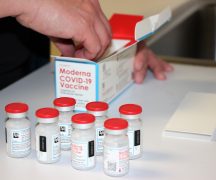The rate of new vaccinations against COVID-19 in Ohio has slowed to a rate not seen since December, according to an analysis of state data.
The seven-day moving average of newly vaccine started Ohioans dipped below 10,000 on Sunday for the first time since Dec. 27 — the tail end of a stretch when some days brought more than 10,000 new infections and 200 deaths from the new disease.
Only 46% of Ohioans have received at least one dose of the vaccine as of Thursday, compared to 52% of the U.S. population.
Average new vaccination rates plummeted in early April as a scarcity of doses gave way to a lack of demand. In mid-May, this trend modestly reversed after the federal government authorized vaccination of children 12-15 and Gov. Mike DeWine announced a series of $1 million lottery drawings for vaccinated Ohioans.
While scarcity defined the early days of the vaccination campaign, spoilage may soon prevail. DeWine said this week that Ohio possesses about 200,000 doses of the Johnson & Johnson vaccine that expire June 23. Ohio has no legal options, he said, for giving the doses to other states or countries.
“For Ohioans who have been waiting to get their vaccine, I urge you to take action now. There are many opportunities throughout the state to get a vaccine,” he said.
“The Johnson & Johnson vaccine is one of those options. It is safe and effective and only requires one shot. In just two weeks, you could be protected from this virus. Getting vaccinated is the quickest way out of the pandemic and the fastest way for us to return to the lives we remember.”
Despite the sweepstakes (still ongoing), vaccination rates began falling by late May.
Estimates vary, but experts believe when somewhere between 70% and 90% of the population is vaccinated, a “herd immunity” effect is produced in which the virus runs out of viable hosts. Thus, people who are medically unable to receive vaccinations or have weakened immune systems are insulated by their vaccinated neighbors.
If Ohioans continue to seek vaccinations at the current race of about 10,000 per day, it will take nearly a year (more than 334 days) until about 75% of Ohioans are vaccinated.
Vaccine coverage is much stronger among older Ohioans than younger.

Some racial groups are underrepresented as well. About 8% of doses have gone to Black Ohioans, who represent about 13% of the state. About 3% of doses have gone to Ohioans who identify as Hispanic or Latino, who represent about 4% of the state.
***
Also from Ohio Capital Journal:
Former congressman Renacci to challenge Gov. DeWine in GOP primary
If Mike DeWine is going to achieve a second term as governor, he will first have to overcome a primary challenge from a former congressman from northeast Ohio.
Jim Renacci, a Republican from Wadsworth, announced a campaign for governor in the 2022 primary election.
It is unusual for a sitting governor to face a primary contender, but the past year has shown that Ohio Republicans are not afraid to take on the top elected official from their own party. This internecine battle has been largely waged at the state legislature and on social media channels. Now it will play out in an electoral sphere.
Renacci served four terms in Congress representing a conservative-leaning district on the outskirts of Akron and Cleveland. He campaigned for governor four years ago in a multi-way Republican primary before switching to run for U.S. Senate. He was defeated in that 2018 race by incumbent Democrat Sherrod Brown. READ MORE





